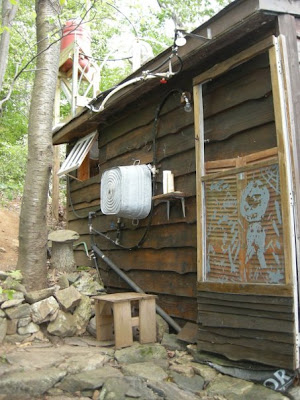The boxed package contains: 1. All necessary bolts, nuts, washers, gaskets
2. Stainless steel insulated tank
3. Stainless steel mounting stand comprised of:
a) Two 47¼ inch angle iron / function: front tube support legs
b) one 42¼ inch angle iron with 13 quarter inch holes / function: reflector holder at lower end of tubes
c) one 42¼ inch angle iron with 2 hole "L" on each end / function: reflector hold at tank end of tubes
d) two 29¼ inch angle iron rear leg / function: mitered end bolts to strap attachment at tank end
e) one 41¾ inch angle iron with "T" at both ends / function: latera support between rear legs
f) two 28½ inch angle iron / function: lateral support between front and rear legs
g) four foot pads with mounting bolts and pins
4.12 vacuum tubes
5.Stainless steel reflector panels
6.Stainless steel inlet and outlet pipes
7.Six plastic protective double tube supports for pointed lower end of tubes
Putting the System together:You may want to refer to the heater picture at the top of this page as you read these step-by-step instructions.
1. Lay tank out so strap attachments are facing up.
2. Bolt rear legs (d) to vertical strap attachments on tank with mitered end of leg bolted at tank end. Install foot pads (g)
3. Bolt lateral support (e) between rear legs (d)
4. Bolt front legs (a) and reflective panel holder (c) to angled strap attachments on tank. Make sure channel (c) opens away from the tank and on the top surface of the leg to eventually hold reflector panels. Install foot pads (g)
5. Bolt lateral support parts (f) between front and rear legs
6. Turn heater system rightside up and stand on legs
7. Bolt lower holder for reflector (b) to top surface of front legs (a) with channel open to tank to eventually hold bottom end of reflectors
8. Install reflective panels with self tapping screws to parts (b) and (c)
9. Put light purple cosmetic gaskets on vacuum tubes, wet outside of tubes with water, and then twist open end of vacuum tubes into inner tank silicone gaskets
10. Bolt black protective tubes supports to holes in (b). To properly install these, it is necessary to twist vacuum tubes farther into tank than required and then twist the tubes back down into holders once they are installed
11. Prepare to install water inlet (bottom) and outlet (top) stainless pipe supplied in inlet and outlet holes in the hot water tank. Before inserting the pipes into the tank, insert and plastic gasket supplied in the outer tank holes and place a "T" fitting (not supplied) on stainless pipe to be installed in upper outlet hole and a 45° elbow (not supplied). The system is now ready to be
plumbed according to
directions provided.
12. If your system becomes dry through evaporation, be sure to fill it when the vacuum tubes are cool to avoid breakage. This is not a problem when the system is used frequently since it is designed so that the tank bottom and tubes won’t drain through use.


















